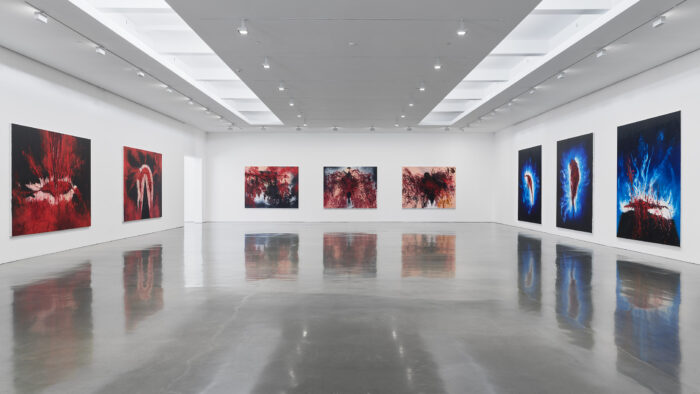

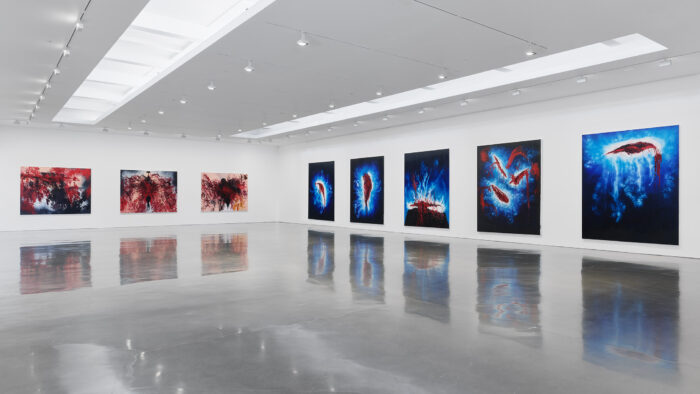
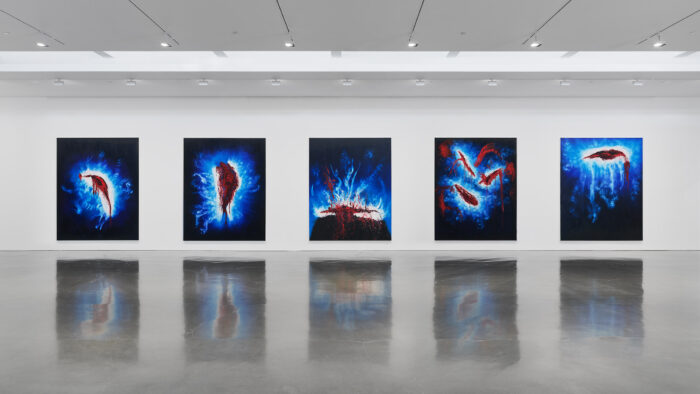
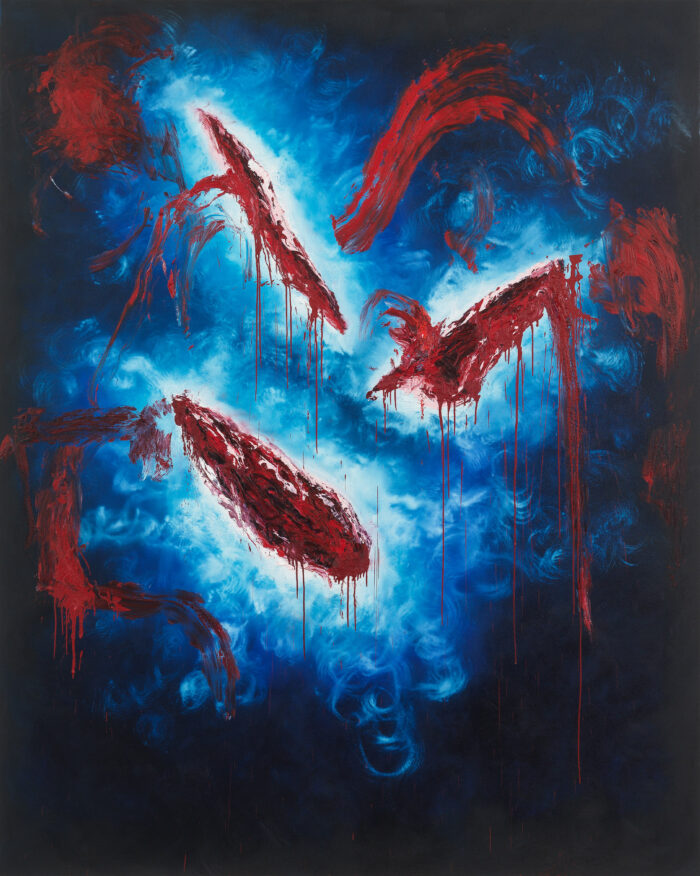

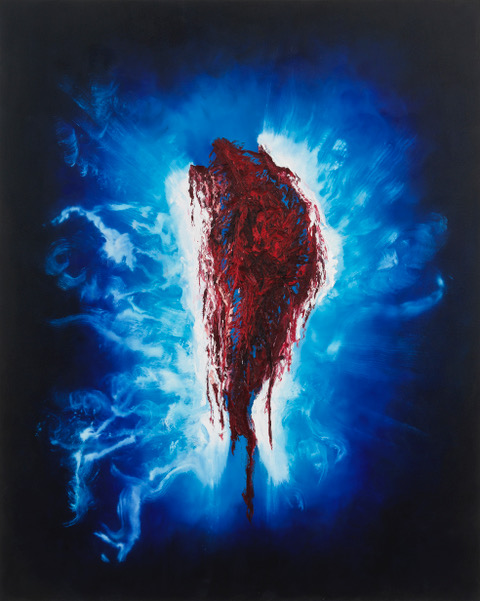
Anish Kapoor at Regen Projects
March 4 – April 15, 2023
PR: Regen Projects is currently presenting a new body of large-scale paintings by renowned artist Anish Kapoor. Over the last 40 years, Kapoor has engaged a diverse range of media and materials to probe the qualities and contradictions of form and perception. This is the artist’s seventh exhibition with the gallery since 1992 and the first devoted entirely to his painting practice.
The works in this exhibition demonstrate Kapoor’s deft handling of paint, with abstract forms created in thick, blood-red impasto set against ethereal expanses of vibrant blue and fleshy peach tones. Otherworldly yet brutally corporeal, these ambiguous forms suggest various states of expulsion. Some erupt in plumes of smoke while others luminesce in darkness; still others do not appear to be forms at all so much as the explosive aftermath of furious strokes and visceral smears of paint.
Long celebrated for sculptures that exploit material, volume, and color to subvert optical perception, over the past decade painting has become an increasing focus in Kapoor’s practice. These works are informed by the same terms that constitute his sculptural language and driven by his abiding preoccupation with the material and immaterial. Kapoor explains:
“To make a work out of pigment is to refer very clearly to the materiality of it: pigment is like earth or clay, stuff that sits on the ground and yet has a kind of weird, wonderful, dreamy quality—it’s what colour does. Or similarly, to hollow out a stone and paint the interior very dark blue, or to do as I am doing in these paintings. It’s the same language.”
— A conversation between Anish Kapoor and Homi K. Bhabha, “Come in under the shadow of this red rock…” from Anish Kapoor: Painting (Walther König, 2022, pp. 362–369)
These paintings animate Kapoor’s longstanding concern with the metaphysical dualities of birth and death, being and nothingness, the transitory and the eternal, the entropic and the sublime—states which convulse together on his canvases, leaving behind the aftermath of what has taken place. Kapoor has encapsulated this sense of temporality in the works—of something that has occurred and may continue to occur—in naming them “painting-acts.” It is within these “painting-acts” that he materializes primordial dramas which seem to precede or altogether eschew rational cognition.
In an essay published in the first monograph devoted to Kapoor’s painting practice, curator and art historian Norman Rosenthal describes the artist’s uncommon mastery of the medium:
“Often the colors and the dense realities that each of Kapoor’s paintings contain come into violent and fluid collision, erupting into pure abstracted landscapes the likes of which have surely not been seen since the late, strange and unexpected works of the English artist J. M. W. Turner… What is so extraordinary about Kapoor’s new paintings, making them inherently new and thus revelatory to their viewers, is that the substance that is paint is applied not randomly, but rather in an aleatoric, warlike series of games of chance. These ultimately lead to a new kind of order that conjures up in each painting—metaphorically of course—a new universe that has its own compositional force created through color.”
— Norman Rosenthal, “Colour, Colour, Always Colour!” from Anish Kapoor: Painting (Walther König, 2022, pp. 170–172)
Anish Kapoor (b. 1954, Mumbai) studied in London at Chelsea School of Art and Hornsey College of Art. He lives and works in London.
Kapoor’s work has been the subject of recent exhibitions at Skulpturenpark Waldfrieden, Wuppertal (2022–2023), Centre of Polish Sculpture, Orońsko (2022–2023), and a major two-part exhibition in Venice at the historic Gallerie dell’Accademia and the Palazzo Manfrin (2022). Previous solo presentations of his work have been held at museums internationally, including Modern Art Oxford (2021–2022); Shenzhen Museum of Contemporary Art and Urban Planning (2021); Houghton Hall, Norfolk (2020); Pinakothek der Moderne, Munich (2020–2021); Fundación Proa, Buenos Aires (2019–2020); Central Academy of Fine Arts Museum and Imperial Ancestral Temple, Beijing (2019–2020); Fundación CorpArtes, Santiago (2019); Pitzhanger Manor & Gallery, London (2019); Serralves Museum of Contemporary Art, Porto (2018–2019); MAST Foundation, Bologna (2017–2018); Parque de la Memoria, Buenos Aires (2017); Museo d’Arte Contemporanea Roma (2016–2017); Museo Universitario Arte Contemporáneo, Mexico City (2016); Rijksmuseum, Amsterdam (2015–2016); Chateau de Versailles (2015); Martin Gropius Bau, Berlin (2013); Museum of Contemporary Art Australia, Sydney (2012–2013); Guggenheim Museum Bilbao (2010); Guggenheim Museum, New York (2009–2010); Royal Academy of Arts, London (2009); MAK – Museum of Applied Arts, Vienna (2009); Royal Institute of British Architects, London (2008); Institute of Contemporary Art, Boston (2008); Haus der Kunst, Munich (2007–2008); Turbine Hall, Tate Modern, London (2002–2003); Hayward Gallery, London (1998); Fondazione Prada, Milan (1995–1996); and Tel Aviv Museum of Art (1993), among many others.
Also renowned for his architecturally scaled works, public projects include Cloud Gate, Millennium Park, Chicago; Orbit, Queen Elizabeth Park, London; Ark Nova, an inflatable concert hall created for Lucerne Festival, Japan; Descension, Brooklyn Bridge Park, New York; and most recently, the Universitá Monte St Angelo and Traiano Metro Stations, Naples, Italy, in addition to a permanent sculpture at 56 Leonard Street, New York.
He has participated in the 2020 Bangkok Art Biennale; 5th and 13th Biennale de Lyon (2000, 2015–2016); 6th Moscow Biennale of Contemporary Art (2015); 14th International Architecture Biennale, Venice (2014); and Monumenta 2011, Paris.
Kapoor represented Great Britain at the 44th Venice Biennale (1990), where he was awarded a Premio Duemila, in addition to participating in the 40th and 45th Venice Biennale (1982, 1993). In 1991, he won the Turner Prize and has gone on to receive numerous international awards including the Praemium Imperiale Award in Sculpture (2011) and the Padma Bhushan award (2012). In 2003, he was awarded the Commander of the Order of the British Empire, and in 2013, received a Knighthood for services to the visual arts.
His work is held in the permanent collections of art institutions including the Museum of Modern Art, New York; Prada Foundation, Milan; Guggenheim Museums, Venice, Bilbao, and Abu Dhabi; The Metropolitan Museum of Art, New York; Hirshhorn Museum and Sculpture Garden, Washington, DC; Moderna Museet, Stockholm; National Gallery of Canada, Ottawa; San Diego Museum of Contemporary Art; San Francisco Museum of Modern Art; Stedelijk Museum, Amsterdam; Tate Gallery, London; Tel Aviv Museum of Art; Vancouver Art Gallery; and Walker Art Center and Sculpture Garden, Minneapolis, among many others.
